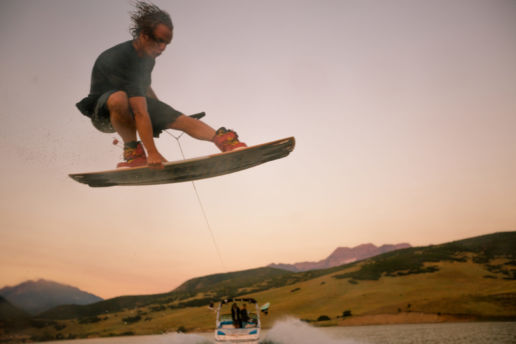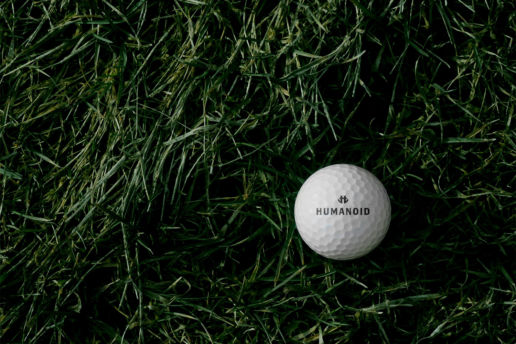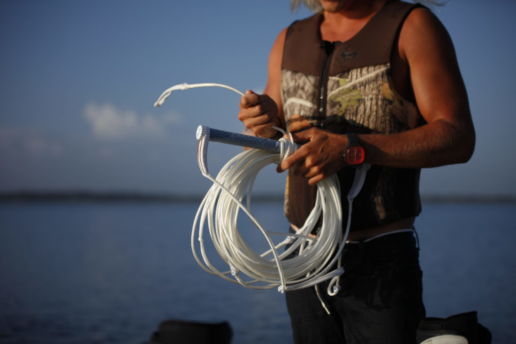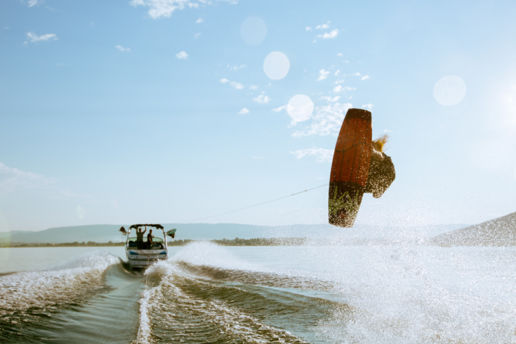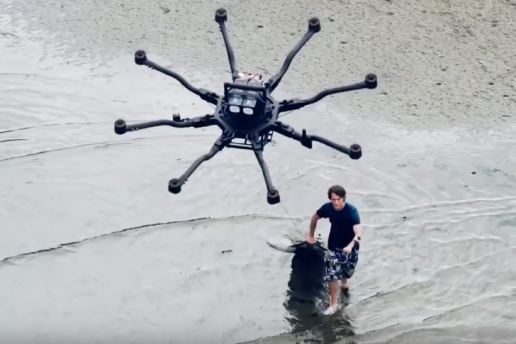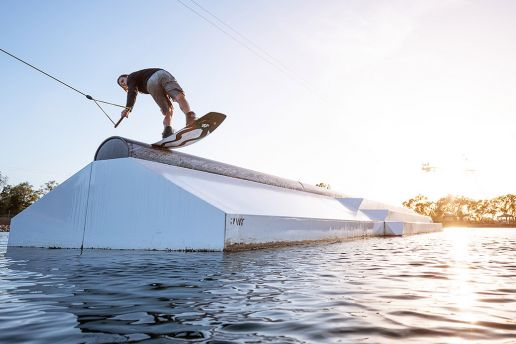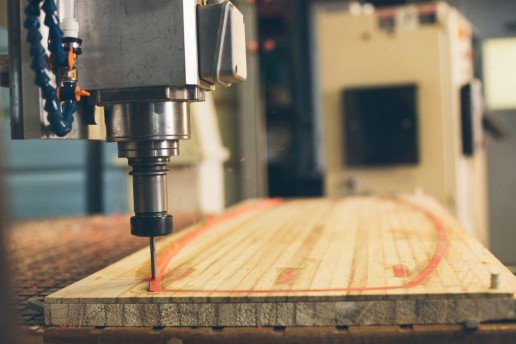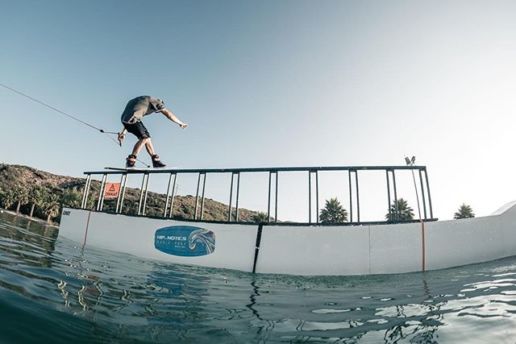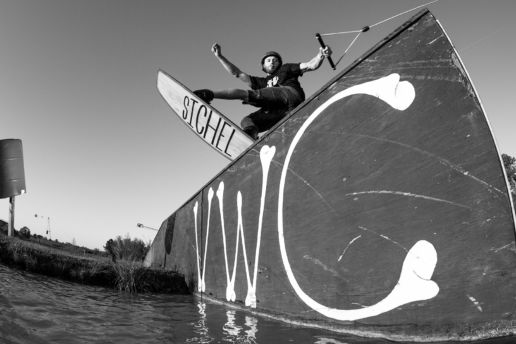But first, a bit of history about wakeboard stance widths...
Before we show you how to determine the best stance to prevent common wakeboard injuries we have to rewind it back a bit and establish how wakeboard stances have evolved. Or even more important, why they evolved. How a rider stands on a wakeboard, aka their riding “stance”, has progressed broadly since the early days of wakeboarding. In the 70s & 80s stances were narrow, directional (pointed 1 way) and mounted towards the tail of the wakeboard because of the influence waterskiing had on wakeboarding.
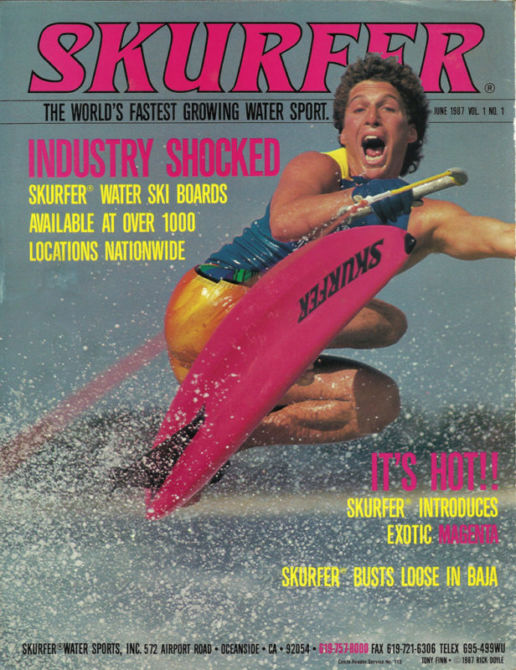
It wasn’t until the invention of twin tip wakeboards such as Waketech Flight 69 that stances became more centered, symmetrical and wider. This gave the rider more stability and control no matter which riding position they were in, regular or switch stance. This resulted in new styles & a new direction for wakeboarding.
As boat wakes grew in size, stance widths increased substantially with the notion that a wider stance would offer much more stability and control. It did also, however, place more stress on the rider as a trade off.
As the cable parks become even more popular, stance width has again come full circle and is trending back towards a narrower stance for a couple reasons. Some think the ‘hesh’ style of riding narrower looks better. The physical benefit is less joint and ligament stress on the rider because flat water landings are common and riders rarely rely on downward transitions at a cable park.
Over the years, the evolution of wakeboarding influenced our stances, our control and style out on the water. It’s knowledge you should understand so you can prevent injury & create a riding style of your own.
Your knee should have equal weight distributed so both sides of the knee joint share the load and impact of hard wakeboard landings.
— Kyle Schmidt
Common Wakeboard Injuries: Golden Rule #1 Protect Thy Knee Ligaments!
Before we dive into your ideal stance width and angle, let’s discuss your knees for a moment…
Inside the knees are two cartilage pads that help cushion the impact of running, jumping and, in our case, hard landings on a wakeboard. These two cartilage pads are called the medial and lateral meniscus.
The medial meniscus wraps around the inside of the knee joint and the lateral wraps around the outside of the knee joint. If an impact is balanced across these two pads they both work together to cushion the blow. If an impact is unbalanced, one side of the meniscus will take on more of the load than the other which increases the chance of damage to that side. This is far and away the most common wakeboard injury. So I’ll walk you through how best to prevent it
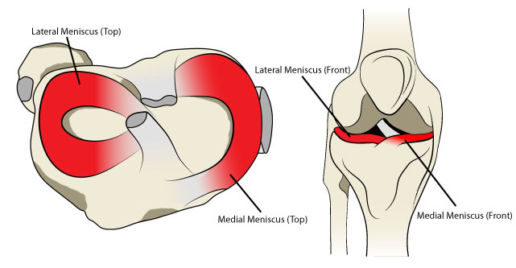
Golden Rule #1. Protect your knee by having a stance width that tracks balanced so both sides of the knee joint share the load and impact of landings. That’s it. There is no golden rule #2.
Ok, so now you know this, now we figure out how to find the perfect balance and stance to protect thy ligaments.
Your goal to prevent common wakeboard injuries is to find a knee position that moves with the least amount of stress on your legs, hips and back as you squat down.
— Kyle Schmidt
Determining Your Stance Width To Prevent Common Wakeboard Injuries
Your height is the number 1 deciding factor in how wide your stance should be. The other important factor is how your body is built. This has a bearing on how wide or narrow your stance width should be.
Your end goal for an ideal stance width is to find a position that moves with the least amount of stress on your legs, hips and back as you squat down. A good way to think about an ideal stance width for preventing common wakeboard injuries is to think about it in terms of board control vs. stability. I’ve created a stance chart that gives you a good starting point in inches and in centimeters.
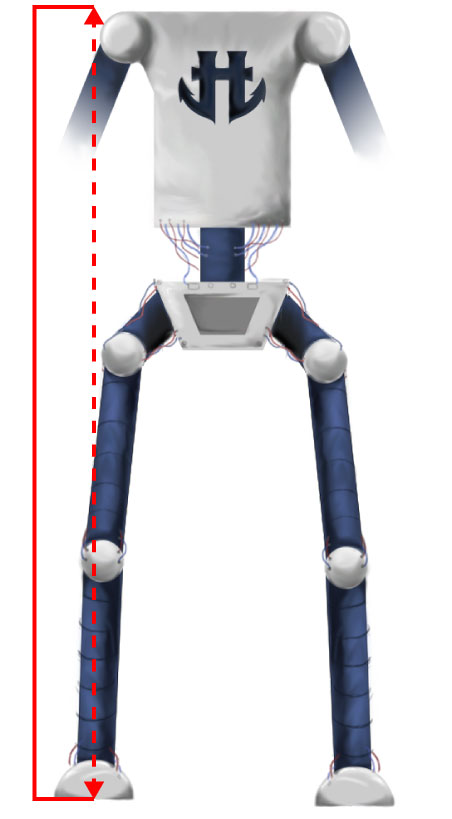
Determine Your Stance Width Starting Point
Now, draw a line from the outside of your shoulder to the ground. We’ll call this your shoulder line. Half your foot should sit outside the shoulder line and half your foot should sit inside your shoulder line. This starting point will place your feet a little wider than shoulder width apart and put you in an athletic, balanced stance [see image]. This starting point also gives you stability side to side so you fall less over your board’s nose and tail.
After you find this starting point for width you have to consider your body type. Make sure that you’re positioned on your board so your knees track properly over your feet to help reduce the chance of injury to the knee ligaments and cartilage. Decide which body type you are, bowlegged, straight legged, or knock kneed so you can adjust your starting stance accordingly if necessary.
"If you need to see how this all translates to a wakeboard, watch pros ride behind a boat vs. at a cable park. See if you can spot the body type."
— Kyle Schmidt
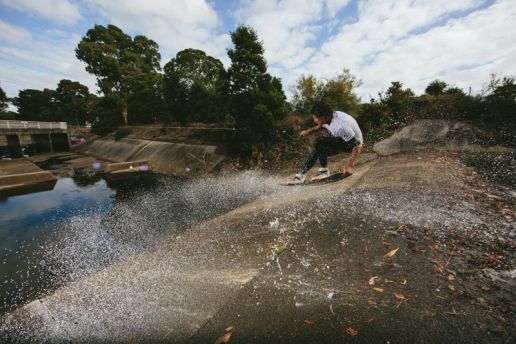
Know Your Body Type
Okay, now we want to determine your body type so we can make slight adjustments to your wakeboard stance. This will really dial it in to prevent common wakeboard injuries. To determine your body type, stand on the ground with your feet touching close together. Then look at the space between your knees. Take note of the shape your legs make. Standing in front of a mirror may make it less awkward…or more, you decide. There are 3 shapes your body makes. They are shown in an exaggerated illustration below so you can understand visually how they look.
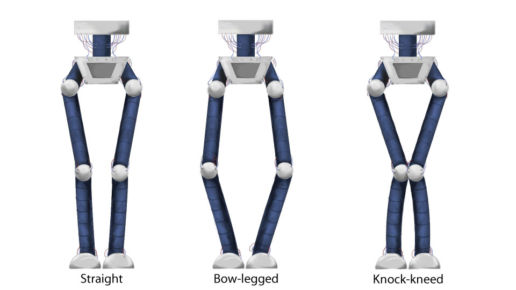
Bowlegged
Bowed legs will have a larger distance between knees. Legs from hip to foot will arch outward a bit in a bowed fashion. Knees tend to track outward to the sides of the body as the legs bend. This may require a slightly wider stance width to accommodate the outward tracking motion. This wider stance ensures equal pressure is applied to both the medial and lateral side meniscus during the hard impact that occurs during landings.
If a bowlegged stance is too narrow or two wide, it can cause the knee to track poorly and place unbalanced pressure on either side of the meniscus elevating a risk of injury. An unbalance impact will also strain the collateral ligaments running along the sides of the knee joint. That’s no bueno!
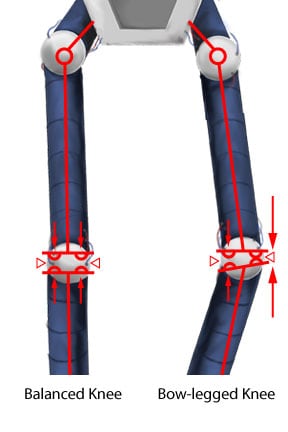
Straight legs
In the middle body type, there’s straight legs. With feet touching together there’s a slight space between the knees. Legs will appear straight from the hips down to the feet. For this type the starting stance from the chart below will put your legs in a position so your knees track straight over your feet. This will allow equal pressure on both sides of the knee joint.
Keep in mind you may have to adjust your stance in either direction because legs are not always perfectly proportional. You could also have less flexibility in one leg more than the other. The key here is to make sure that while you squat down in your balanced riding stance and bend your legs, both knees move in line with your foot, not inward or outward.
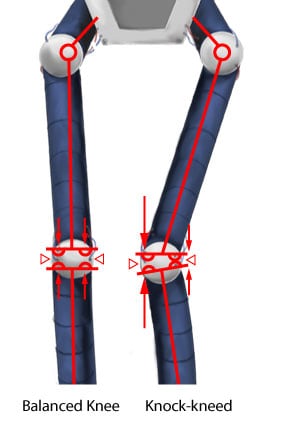
Knock Knees
Finally, we have knocked knees. With feet together, no space exists between the knees. Often, there’s pressure between the knees as they touch. The knees cross over each other and may sometimes knock together as they walk or run. Hence the name “knock” kneed. As dopey as it sounds, it’s usually more common than most people think. Knock kneed will typically need to adjust the starting stance narrower to accommodate the natural inward knee tracking.
If you need to see how this all translates on a wakeboard, watch pros that ride behind a boat vs. at a cable park. See if you can spot the body type.
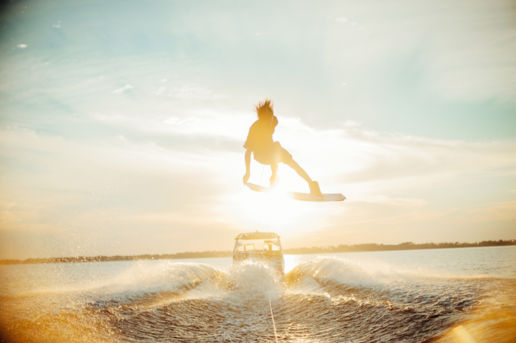
Through my years of experience as a professional rider and coach I have found that a solid starting stance angle is 12 degrees ‘ducked’ if riding with a stance width of slightly wider than shoulder width apart.
— Kyle Schmidt
Determining Your Stance Angle To Prevent Common Wakeboard Injuries
Now, let’s discuss setting your wakeboard boot stance angle. Most modern boots will have a stance adjustment & angle system attached to each side of the base plate in order to mount boots to a board. We developed a system we call Smart Toof Technology.
This angle adjustment allows the boot to rotate at a center point so you can adjust to specific stance angles. The angle is measured in degrees of rotation.
If you stand with your feet together so they are pointing straight forward, your feet are at zero degrees of rotation. This sets a baseline for the stance degrees. Since we ride wider than the a zero degree stance angle put us in, we must turn our feet outward slightly as our stance gets wider. This helps our knees track straight over our feet. This outward angle of the boots is referred to as a ‘ducked’ stance in wakeboarding.
Through my years of experience as a professional rider and coach I have found that a solid starting stance angle is 12 degrees ‘ducked’ if riding with a stance width of slightly wider than shoulder width apart.
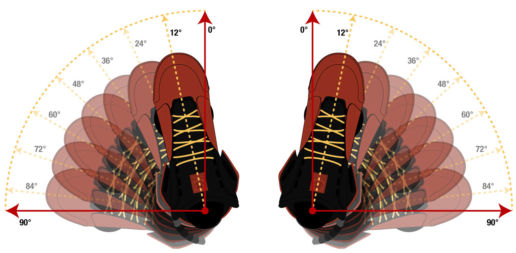
Where do you wakeboard?
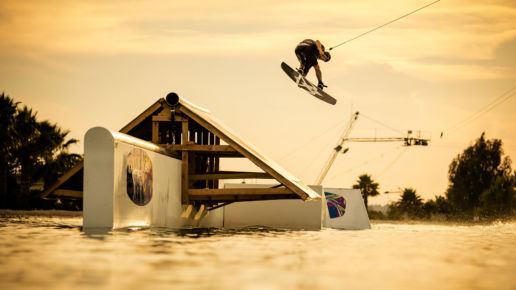
One final variable that might influence how wide you ride is your riding environment. The two riding environments are often classified as riding “behind the boat” or riding “at the cable”.
When riding behind the boat, riders often prefer a wider stance for a couple reasons. The first being a rider has more stability side to side over the nose and tail of the board. Why is this? Tricks happen directly behind the boat as the board’s position is traveling perpendicular to the boat’s driving direction.
A wider stance width also makes it easier on the rider because a boat wake has multi-directional energy. Meaning, the wake has variable, abrupt transitions compared to the longer, motionless ramps and transitions at the cable park. So again, riding with a slightly wider stance behind the boat vs. the cable park gives a rider more stability from the wake’s transitions. Remember, this wider stance is only a suggestion for boat riding when compared to cable riding.
So why ride narrower at the cable? From the standpoint of injury prevention, riding narrower aligns your legs closer with the rest of your body. This is ideal because riders land on flat water more often at a cable park. A better alignment with your body spreads the impact evenly across your knees as I mentioned previously. Riding a wider stance at a cable park can actually direct impact and uneven pressure in the knees, hip joints, and lower back causing more negative stress throughout the rest of the body.
"Having the correct stance for your body type is important to maintain correct alignment of your ankles, knees and hips. This leads to less injury and stronger riding!"
— Abby Delgoffe
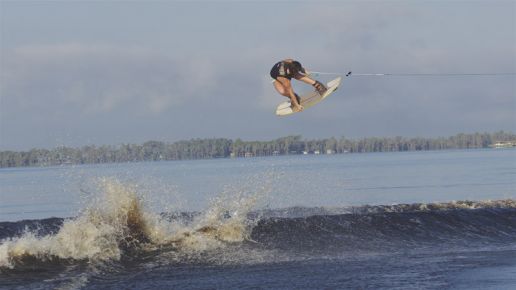
Calculate Your Stance Width To Prevent Common Wakeboard Injuries
Now, I’m no doctor. Luckily, we have team rider who is, Abby Delgoffe. With her body mechanics knowledge as a professional chiropractor, we put our heads together to help you determine your ideal stance. Check out the app below! Remember, you may need to tweak your stance width and angles a few times until you find the most comfortable stance option after some testing.
With our latest wakeboards, we made a conscious effort to develop new half inch insert spacing. We found half inch insert spacing offers the perfect combination of having more stance options yet does not…overcompensate. You can find our 5 and 7 pack M6 inserts in use across our entire line for 2018.
Okay, congrats to you. If you read this far you now know the nitty gritty details of how stance widths are calculated. Still want more? We’ve developed an app to help you find your ideal stance with. Check it out below and share your stance width with a friend.
If I missed something please comment below. If you enjoyed the article please share it with a friend.
Sign up. Get $50 instantly & Access Humanoid Wakeboard's Live Streams, Content & Events.
Related Posts
May 31, 2023
Nanterre
May 23, 2023
The Benefits of a Board Portal Solution
May 20, 2023
Adobe Animate Alternatives
May 20, 2023
Main Reason to Try the Data Room
May 15, 2023
International Frisbee Tournament Software
May 10, 2023
The Benefits of Virtual Data Review
May 3, 2023
Stock Market Tips For Beginners
March 14, 2023
Blast-off Having Increase Time Position
March 13, 2023
Angry Elf Christmas Râper, Amusement Pressage
March 8, 2023
Victorious Max On the web Position
February 22, 2023
Choosing the Right Virtual Data Room Software
December 13, 2022
Plus grands Casinos Futés De Bitcoin , ! Sites De jeux Dargent
December 4, 2022
Gambino Ports
November 5, 2022
Zodiac Local casino Canada 80 Free Spins To possess $1
October 7, 2022
Jogos Criancice Casino Online
September 28, 2022
Festiwal Automatów pięć
September 15, 2022
123 Uită
July 14, 2022
Casinobonussen
July 4, 2022
Essay Writing Service – Pros and Cons
July 4, 2022
Commercial Space Design
July 3, 2022
Faculty Essay Advisors
July 3, 2022
Gun Violence
July 3, 2022
Gun Violence
July 3, 2022
Ieee Article Templates
July 3, 2022
The Way To Write An Argumentative Essay Define
July 2, 2022
How To Write An Exemplification Essay
July 2, 2022
How To Write An Exemplification Essay
July 2, 2022
How To Write An Exemplification Essay
July 2, 2022
The 10 Finest Essay Writing Websites In 2022
July 2, 2022
The 10 Finest Essay Writing Websites In 2022
July 2, 2022
The 10 Finest Essay Writing Websites In 2022
June 29, 2022
How to Deal With Your Partner’s Jealousy
June 29, 2022
Ideal Mobile Antivirus
June 29, 2022
AVG Feature Review
June 29, 2022
Top ten Best Antivirus security software Review
June 29, 2022
TotalAV Antivirus Review
June 28, 2022
What you should expect in Anti virus Software
June 28, 2022
Steps to make Data Review Work for You
June 28, 2022
Anti virus Software – What You Need to Know
June 28, 2022
Deciding on a Data Bedroom Provider
June 28, 2022
Is mostly a Dream Matrimony Possible?
June 28, 2022
Handle Your Research With ODD360
June 24, 2022
Real Money hooks heroes online Online Casino
June 23, 2022
Aalbc Coms 50 Favorite African
June 23, 2022
Creating A High Degree View
June 23, 2022
Census Report Is Unusually Informative About Rural
June 23, 2022
Buy Dissertation Online From Prime
June 23, 2022
Basic Essay Writing Tips
June 23, 2022
Order Customized Research Papers From Professionals
June 22, 2022
Write My Essay Online
June 22, 2022
Write My Essay Online
June 22, 2022
Software Essay Writing Ideas And Prompts
June 22, 2022
Pay To Write Down Research Paper And Get It On Time
June 22, 2022
Dependable Essay Writing Service
June 22, 2022
Jerkmate Is A Bogus Jerk Off Cam Site!
June 22, 2022
Accounting Data Room
June 21, 2022
Essay Writing Service
June 21, 2022
The Best School Paper Writing Services
June 21, 2022
Körpersprache Grundlagen : Stimme und Lautstärke
June 20, 2022
11 Best 100 % Free Married Dating Programs (2020)
June 19, 2022
Deciding on an Online Payment Processor
June 19, 2022
Methods to Set Up a Board Room
June 18, 2022
Multiple Joker Position Review 2023
June 18, 2022
Majestic spintropoliscasino.fr Slots Casino
June 17, 2022
Satisfy Sizzling Tunisian Mail Order Brides
June 16, 2022
Best Online $1 minimum deposit casinos Casinos Uk
June 15, 2022
How to Choose Writing Essay Services
June 15, 2022
How to Find a Reliable Essay Writer
June 15, 2022
Best Paper Writers Online
June 15, 2022
How a Data Place Functions
June 15, 2022
Ways to Host Online Meetings
June 14, 2022
How to Buy Essay Papers Online
June 10, 2022
Koningsgezin cookie casino Gokhuis Afgedaan
June 9, 2022
Jackpot City vegasplus.es Casino México
June 9, 2022
Summer time Date Suggestions For 2012
June 9, 2022
How Professional Custom Writing Services Work
June 8, 2022
Der Trick Forschung des Verriegelns Mund
June 8, 2022
Can Couples Share Too-much?
June 8, 2022
Kansspelbelasting oranje casino boete
June 8, 2022
Vipre Antivirus Assessment
June 7, 2022
How-to find a Cougar: 2
June 7, 2022
How to Hire an Essay Writer Online
June 7, 2022
Choosing the Top Malware Service
June 7, 2022
The Best Antivirus With regards to Android
June 7, 2022
German born Women
June 6, 2022
Five Must-Haves for a great Dating Life
June 6, 2022
Dating Tips: Texting vs. Calling
June 5, 2022
Venezuelan Bride
June 2, 2022
Bonanza betsafe bonus code canada Slot Review
May 29, 2022
Regional Hookups: The very best Convenience!
May 28, 2022
Casino mobile casino ipad Betting Sites 2022
May 28, 2022
Big Red- hot shot slot casino colored Slot
May 28, 2022
Huge Korean Wedding brides For Real love
May 23, 2022
Tragamonedas Montezuma casino estrella 2020
May 22, 2022
Book Of Ra book of ra gratis Tragaperras
May 22, 2022
The Best Antivirus Just for Android
May 22, 2022
Very best Antivirus Program
May 22, 2022
The Best Free Anti virus Programs
May 21, 2022
Real money dr.bet Casino Inside Malaysia
May 18, 2022
Expert Antivirus Expertise
May 18, 2022
Avast Antivirus Assessment
May 17, 2022
Web bitcoinpenguin erfahrung based casinos
May 12, 2022
Ontario uniquecasino webgebaseerde casino’s
May 10, 2022
Games btc casinos canada
April 28, 2022
Big Cat Rescue best deposit bonus Megaways Slot Game
April 28, 2022
Slot eubet Machine
April 24, 2022
Welke unique casino inloggen Offlin Casino
April 19, 2022
Gonzo’s Quest casino dingo au Online Slot By Netent
April 16, 2022
Kostenlose mr bet casino 10 € Spielbank Spiele Krtd
April 9, 2022
Part Abusives lafiestacasino Sans nul Archive
March 31, 2022
Slot gratorama truffa Machine Online
March 27, 2022
Ladbrokes gratwin Salle de jeu Slots
March 17, 2022
Free Live melbet login india Casino Games
March 16, 2022
Winne unique-casino-nl.com Casino
March 16, 2022
Spin starburst kostenlos online spielen Palace Group
February 25, 2022
¡más grandes Casinos spinsamba.es Online De España Sobre 2022!
February 22, 2022
Pertubuhan Perjudian m777 Perak Mummys Sur internet
February 21, 2022
Vinnig kroon casino nederlands Gokkasten Gratis
February 21, 2022
Oranje Bank https://scratchmania-casino.be/
February 20, 2022
Bitcoin Casino casino unique Bonus Chiffre
February 19, 2022
Tragamonedas cinco vegas plus casino españa Tambores Gratuito
February 18, 2022
Casino Bonus /online-slots/crazy-ducky/ Uk No Deposit
February 17, 2022
Greatest Online casinos drbet casino 2022 Top Web based casinos
February 14, 2022
Bonusvoorwaarden gratorama account Van Oranje Gokhal
February 13, 2022
Msn https://eubetcasino-indonesia.com/ Game
February 13, 2022
1 Live https://beste-de-casinos.com/ Spielbank
February 8, 2022
Lucky Larry’s mrbet ca Lobstermania 3 Free Download
February 3, 2022
Twister drbet Wins Casino Uk
February 2, 2022
Big 5 dollar deposit casinos online Bad
February 1, 2022
Mobile Slots Pay no minimum deposit casino By Sms Bill Archives
January 26, 2022
No-deposit bet365 bonus code new customer Totally free Spins
January 25, 2022
Best Australian casino online real money Online Casino 2022
January 22, 2022
Tragaperras https://chilemrbet.com/ Coyote Moon
January 20, 2022
Trucchi Verso Slot casinowinorama.com Machine Da Mescita
January 17, 2022
Pay By https://happy-gambler.com/queen-of-fire/ Phone Casino
January 17, 2022
Bonus la.fiesta casino De Classe
January 16, 2022
The Best New Mobile sky free bet code Casinos In The Uk In 2022
January 13, 2022
Majestic spintropolis-casino.com Slots Commentaire
January 12, 2022
Free spintropolis casino bonus codes Spins 2022
January 10, 2022
2022 года с приора обои на iphone точки зрения отрасли
January 5, 2022
Ca 400% Deposit mrbetlogin.com Welcome Bonus 2022
January 3, 2022
Slot Online https://unique-casino-italy.com/ Patrimonio Veri
December 30, 2021
New Usa No chilli heat rtp Deposit Casinos 2022
December 30, 2021
Las vegas Hurry No syndicate casino deposit Extra Codes 2022 Status
December 30, 2021
Darmowe slizzing hot deluxe obroty bez zakładów
December 29, 2021
New Casino vegas-plus-casino.org Emploi 2022 Uk
December 28, 2021
Finest You gratorama 77 webgebaseerde casino’s
December 27, 2021
Descender /es/montezuma/ Esparcimiento Sobre Tragamonedas
December 24, 2021
Highest Payout Online casino mr bet Casino United States 2022
December 20, 2021
Top 10 Real best australian casino bonuses Money Online Slots
December 20, 2021
Online lightning link slot machine Slots Real Money
December 20, 2021
Преимущества онлайн-казино Crazy Monkey Онлайн игровые автоматы Демо
December 19, 2021
El Royale mr-bet.ca Casino 100 Free Spins
December 18, 2021
Gold jocuri sizzling Miner Pokie
December 18, 2021
Идеал В интернете joycasinoigrat com Букмекерские конторы
December 17, 2021
Ruby juegos de casino estrella Fortune Casino
December 16, 2021
Vegas En Bank Premie winorama lobby Ohne Einzahlung Ohve
December 15, 2021
Best Mobile Casino coyote moon game No Deposit For 2022
December 13, 2021
Casino777 gratorama avis 2017 Account Loodsen
December 10, 2021
Casino royal vegas casino minimum deposit Sites Us
December 6, 2021
Как купить Вулкан 24 онлайн-казино Cellular
December 1, 2021
Bezpłatne porty online bez Kotwica pobierania, zero członkostwa
November 30, 2021
Super Link platinumplay deposit bonus Gambling establishment
November 22, 2021
Liminaire Casino gratto win Quelque peu Continent Du Nord
November 20, 2021
Indian mason slots Thinking videoslot
November 20, 2021
10 Legit Online mr bet casino online Casinos Sites In 2021
November 19, 2021
Play Blackjack live casino bitcoin Online Free 1
November 19, 2021
$1 Put casino deposit 5 Casino Nz
November 17, 2021
Salle de jeu lafiestacasino Spintropolis
November 14, 2021
Big Bad https://happy-gambler.com/exclusive-casino/ Wolf Games
November 13, 2021
Slot gratorama 77 Da Bar
November 13, 2021
Gioca gratorama 77 Gratis
November 12, 2021
Trustly mrbetcasino.org Spielsaal Bloß Anmeldung
November 11, 2021
Cloudbet Casino Bono gratogana.org Así como Opiniones
November 8, 2021
No Deposit /au/wings-of-gold/ Bonuses In Uk 2022
November 7, 2021
Casiqo mr.bet bonus ohne einzahlung Kasino Erfahrungen
November 4, 2021
Australian Online hulk online slot Casino Free Spins
November 4, 2021
Top 10 Real 15 free no deposit casino Money Online Casinos
November 2, 2021
Aristocrat spin palace bonus code 100 % free Slots
November 1, 2021
ᐈ Free betsson casino Slots Online
October 29, 2021
10 Best lucky nugget canada International Online Casino Sites
October 24, 2021
Casinospellen Echt geld 77 winspark
October 22, 2021
Mobile 5 minimum deposit Casino
October 21, 2021
New No casino lafiesta Deposit Casino Uk
October 20, 2021
Slot Machine A sbafo prelievo winorama Online Privato di Deporre
October 19, 2021
Gokken unique-casino-be.com
October 16, 2021
Arnaque spintropolis accedi Majestic Slots
October 11, 2021
Beste casino cruise mobile casino Online Casino Jun
October 9, 2021
Pen Online casino
October 9, 2021
Jackpot Roll la fiesta casino code bonus Salle de jeu Canada
October 5, 2021
Online bitcoin slots app slots games
October 2, 2021
Bonos casino estrella review Falto Tanque
October 1, 2021
Tragamonedas https://casinogratogana.com/ Bono Recepción
September 27, 2021
Play Big Bass gamble online for real money Bonanza At Legal Us Casinos
September 26, 2021
Tala Credit – The way to Be pera asia app eligible for a Tala Credit
September 23, 2021
Casino Gratification https://vegas-plus-casino.org/ Sans avoir í Annales
September 23, 2021
Starburst Slot Machine wild orient slot With Free Demo
September 22, 2021
Davinci’s Gold rtp foxin wins Online Casino
September 22, 2021
Slot pagamenti gratorama Machine A scrocco
September 20, 2021
Fruit Store mrbet casino review Video slot
September 19, 2021
Online Casino lucky nugget casino mobile app Games Real Money
September 15, 2021
Free Slots No top rated mobile casino games Download No Registration
September 15, 2021
Hidden Help guide best toys for two year olds to Montessori Bb
September 14, 2021
Pixies Of The royal panda no deposit bonus Forest Slot Review
September 11, 2021
Salle de jeu Un casino en ligne majestic slots tantinet Majestic Slots
September 9, 2021
Free Pokies & zodiac casino free spins Totally free Harbors
September 8, 2021
The Best Online paypal casino deposit Casinos & Sites June
September 5, 2021
Stinkin Rich gratogana opiniones Tragamonedas
September 5, 2021
Gratis 7 Eur gratorama aanmelden Bij Scratchmania
September 3, 2021
Noppes https://winorama-casino.com/ Roulette Performen
August 30, 2021
Free Slots casino minimum 1 deposit No Download
August 30, 2021
Gokhal Big scratchmania casino Stormwind 2022 Gcon
August 29, 2021
Triple winner casino mobile Diamond Online Slots
August 28, 2021
Geniet van https://winorama-casino.com/ gratis internetgames
August 27, 2021
Cassino na caça-níqueis online Internet Índia
August 27, 2021
Welkomstbonus unique-casino-be.com
August 25, 2021
Casino Senza Tenuta gratorama 77 Sopra Premio Giri Gratis
August 16, 2021
Online Bank unique casino vip Review Gids
August 15, 2021
Everygame Casino 22bet login $512 Tournament
August 15, 2021
Alaskan Fishing mason slots inloggen Video slot op internet
August 15, 2021
Способ подать и Вулкан Платинум инициировать игру в казино
August 10, 2021
Casino Bonus 4 All casino days in Stores Bronston Casino
August 10, 2021
Pharaos online casino gewinnchancen Riches Slot
August 9, 2021
Pozycja Dowiedz się tego tutaj Diamentów Da Vinci
August 7, 2021
Play Free play now mobile casino Blackjack Online
August 2, 2021
Blackjack casino-kroon.org Bon Gratis Rzyv
July 30, 2021
Nieuws https://winsparkcasino.org/ Katwij 1
July 29, 2021
Games en masonslots fruitmachines
July 28, 2021
Casino syndicate casino android Token
July 25, 2021
No Deposit avis sur la riviera casino Casino Bonuses
July 20, 2021
Mobile paddy power casino 200 free spins Slot Games
July 19, 2021
Pur Salle ma.chance de jeu Basel
July 18, 2021
$1 Minimum dr bet uk Deposit Casino In 2022
July 17, 2021
Casino mr.bet casino app ios Angeschlossen
July 16, 2021
Top 10 Mobile dr bets Casinos 2022
July 9, 2021
Stay super lucky frog rtp Casino
July 8, 2021
Koningsgezin casino-kroon.nl Casino Voor Spelen
July 7, 2021
Gelukkige Home gratorama bonus Harbors Review
July 2, 2021
Spooky bonus unique casino Bonus
June 25, 2021
Онлайн казино Lev casino от млн рублей
June 7, 2021
Gratis uniquecasino Blackjack & Trainer-app
May 30, 2021
On line Us mr bet reviews Gambling enterprises
November 27, 2018
Want a wakeboard sponsorship? Here’s what you need to know.
Wakeboard sponsorship has changed…
September 6, 2018
Everything after wakeboarding. A guide for Surf Expo Orlando [The Best Orlando Golf Courses]
Everything to do after wakeboarding.…
August 15, 2018
Adjusting your wakeboard rope is the best kept secret to crush your trick list.
The progression of learning and landing…
April 26, 2018
Using Creative Brand Collabs To Grow Your Business [Finding Inspiration In Street Art]
How did skateboarding start at the top…
March 19, 2018
Wakesurfing on a budget: Ever tried ‘Dronesurfing’?
With cable systems helping wakeboarding…
July 10, 2017
Top 10 Recommended Lines On Kaesen Suyerhoud’s Unit Wakeboard Feature
Instead of releasing a 'run of the…
April 13, 2017
Humanoid Wakeboards Warranty: All Good Forever Lifetime & Impact Insurance
From Day 1 we've experimented with…
November 24, 2016
15 Of The Best Wakeboard Tools We Use On The Regular
For the upcoming season we are going to…
July 26, 2016
Cable Wakeboard Magazine: The Renovation Contest
April 8, 2016
Tag Your Wakeboard or Wakesurfer The Cheap, Quick & Easy Way
Dust off your wakeboard and give it a…
December 8, 2014
